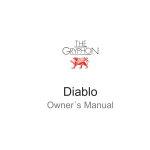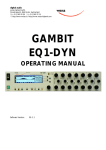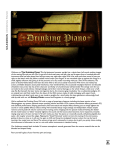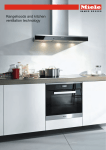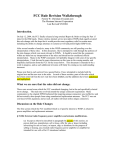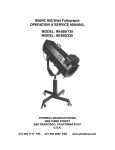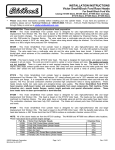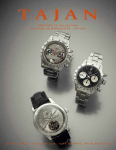Download manual
Transcript
Cantata Owner´s Manual Can-ta-ta A musical composition, often using sacret text, comprising recitatives, arisa and choruses. Table of Contents: Introduction....................... The Gryphon....................... The Man.............................. Made in Denmark............... Musical Objectives.............. The Gryphon Master Tape Collection............................ Exterior Design................... Cantata design story........... The Bass............................. The smaller speaker........... The Gryphon Cantata......... The design......................... Choice of Cables................. A long process..................... The Cantata Q Controller..... Best of both worlds.............. The Cabinet......................... The Drivers.......................... Set-up.................................. Assembling the Speaker...... Connecting the Q Control.... Cantata and the listening room Speaker placement.............. Selecting the Q Factor......... Break-in................................ Room placement.................. Manufacture and Assembly Choice of cables.................. Care and Maintenance........ Tweak Alert.......................... Warranty.............................. Specifications...................... 3 3 4 4 5 5 5 6 7 8 8 9 9 9 10 11 11 13 15 15 16 17 18 19 19 20 21 21 22 22 23 24 and concert hall dimensions are necessary components. Dynamics and an unambiguous sense of instrument location even in the loudest passages are also high priorities. To achieve these objectives, Gryphon products offer exceptional speed and agility along with seamless coherence in the time domain. Introduction Welcome to the global family of proud owners of fine audio components from Gryphon Audio Designs of Denmark. Your new Gryphon unit has been painstakingly designed to re-create the sound of live music taking place in its original recorded space. Every Gryphon product is designed to cater to the needs of the most discerning music enthusiast with sumptuous styling and superb user-friendliness which elevate it above the mundane world of conventional audio components. Since 1985, Gryphon Audio Designs has quietly gone about the business of creating fine home audio components. We know that you will appreciate and enjoy the benefits of our accumulated experience and share our abiding passion for music. As audiophiles, the members of the Gryphon design team are constantly reminded to keep their priorities straight. We are not involved in “hi-fi” for its own sake, but strictly as a means to an end, in the service of our lifelong love of the live music experience in all its sonic and emotional glory. The Gryphon In Greek mythology: A fabled creature, half-lion and halfeagle, combining the power of the “King of Beasts” with the grace of the “King of Birds”. The guardian of the source of gold and protector of the Dionysian cup of infinite wealth. In the real world: An acclaimed Danish audio engineering company employing cutting edge technology and common sense in the pursuit of the purest musical experience. We feel that the gryphon is an appropriate symbol for our high sonic goals. Our higher goal is to bring to the listener a “You-Are-There” sensation. In taking up this challenge, the Gryphon designers go back to basics to analyze the essential nature of the live music experience. For us, an awareness of soundstaging, ambience 3 Following the immediate success of the Gryphon brand, all import business was phased out in 1993, so that Rasmussen could dedicate his efforts entirely to Gryphon. The Man Gryphon Audio Designs is the brainchild of Flemming E. Rasmussen and the fulfillment of a lifelong dream to allow the purest essence of the live music experience to be recreated in the home environment. Flemming E. Rasmussen painting 1967 The Gryphon Head Amp 1985 Made In Denmark Every product from Gryphon Audio Designs is designed and built in Denmark. This is much more than just a geographical fact. It is also a seal of approval, a stamp of quality. Living in a region with no natural resources (no oil, coal, precious metals, etc.), the Danes have learned to rely on their quick wits and skilled hands. Innovative technology, beautiful craftsmanship, pride in one’s craft and a keen eye for attractive design are some of the long-standing Danish traditions which are distilled to their finest essence in every unit that bears the Gryphon name. Rasmussen holds a degree in painting and graphic arts from the Aarhus Art Academy, Denmark. During his studies, Rasmussen developed close relationships with the local music community and designed many LP covers and concert posters. After graduation, he taught photography and painting and designed textiles, before founding 2R Marketing, which quickly became Denmark’s leading High End audio import company. Gryphon Audio Designs was founded in 1985 as an offshoot of 2R Marketing, The first product, the now legendary Gryphon Head Amp, grew from a one-off spare time project developed only for the designers’ own home systems. Although the Gryphon project was initially strictly a hobby, not an actively pursued commercial venture, demand generated by reviews and wordof-mouth led to the formal establishment of Gryphon Audio Designs as a separate corporate entity. Musical Objectives While scientific method and sophisticated technology play an important role in our electronics design work, at Gryphon we never lose sight of the fact that the keen ears of an experienced listener are the most crucial “calibration tools.” Therefore, every 4 Gryphon product exists for one simple purpose: to bring the user closer in the never-ending quest for a more natural and convincing musical illusion. Exterior Design From the very beginning, every Gryphon product has offered stunning audio performance, sumptuous styling and superb user-friendliness, catering to the needs of the discerning audiophile who demands musicality, convenience and aesthetics, all without compromise. Every Gryphon design has been built to cruise effortlessly through even the most demanding musical passages, regardless of volume level, with a musical presentation defined by supreme articulation and immediacy, subtle dynamic shading and razorsharp focus. Refinement and delicacy are combined with power and authority for a natural, involving listening experience. In every Gryphon product, form follows function in a unique synthesis of aesthetics and practicality. Gryphon stands for sophisticated technology with a high standard of industrial finish that also incorporates the best of handcraftsmanship. The peerless finish, build quality, ergonomics and pride of ownership that contribute to the totality of the Gryphon concept can only be fully understood and appreciated up close and in person. The Gryphon Master Tape Collection In the Gryphon listening rooms, we are fortunate to possess a unique library of more than 1,000 original master tapes of recordings made during the Golden Age of studio engineering from 1956-1976. Gryphon is located in beautiful tranquil surroundings. Rasmussen’s background in fine arts and industrial design gives every Gryphon product a distinctive, luxuriant finish which arises organically out of the audio circuit design and the user interface for a truly unique integration of form and function. Unlike conventional commercial releases, our master tapes capture the dynamic contrasts and subtle inner harmonic structure of the musical event, forcing us to work to a higher standard in our efforts to maintain the integrity of the original musical performance. 5 dedicated, purpose-built listening room. Most of us listen to music in a room that also serves as the living room. There are several ways to address this challenge. Here are the most common “solutions”… Cantata design story As with all things known to man, loudspeakers are subject to the laws of physics and to the limitations of human perception. We may bend, manipulate or mask or exploit these laws and limitations, but we cannot ignore them. A. The room can be treated in several ways by using passive and/or active absorbents, bass traps, diffusers and other devices. Unfortunately, these methods are usually expensive, an eyesore in the living room and of limited success. In most cases, they simply change the flavor of the problem. In the quest for the finest speaker, music lovers audition numerous models and finally settle on what they believe to be the “best” speaker. What else can you do? But is the “best speaker” truly the best speaker? If you are lucky, you will end up with a speaker that is the best match for a particular room, a speaker that might be a complete disaster when set up in a different room. This explains the differences in opinion about speaker performance. The performance/quality of any given speaker changes radically, depending on its environment. B. In recent years, sophisticated “room correction systems” have been introduced. The term Room Correction is quite misleading insofar as none of these systems actually correct the room in any real sense. They electronically manipulate the sound of the audio system in order to obtain a better measured match to the room, much like previous generations of equalizers that merely changed the tonal balance of the sound. Unfortunately, they typically introduced a whole new set of problems and are not usually used in high end sound systems. Lastly, a number of correction In general, a loudspeaker can be no better than the listening room allows it to be. Cantata prototype Therefore, the listening room is the most important element in a high performance sound system and for this reason is often referred to as the final frontier. Few people have the luxury of a 6 systems are basically computers that digitally manipulate the sound for the same reasons. These systems are more sophisticated and can address the task with great precision. However, many critical listeners agree that the digital conversions and extensive signal manipulation involved have a high price, and not just the one on the price tag. The Bass The most severe problems usually occur in the bass region, typically due to designers’ overimaginative attempts to circumvent the laws of physics. Most people prefer a speaker with full frequency response from the delicate high-frequency shimmer of a triangle to the lowest notes of a church organ. All speakers should ideally provide superior high frequency performance, but speakers with full output at low frequencies require large drivers and consequently large cabinets with huge internal volume. Low frequencies also require movement of large amounts of air in the room. There is little to be done about these physical facts, as long as we look at the loudspeakers in isolation. C. The most popular solution is to experiment and mix products with different flavors and especially to seek out a speaker that has a complementary sonic signature to that of the listening room. At best, “neutral” performance is obtained by forces reacting in different directions, hoping for tonal equilibrium. This is an art approaching alchemy and the proud owner’s fragile house of cards collapses if any of the components, especially the listening room, is changed. For many audiophiles, this ongoing quest to find the sonic Holy Grail through constant experimentation is what it is all about. Most music lovers simply want to listen to great music with great sound without needless hassle. Another often overlooked fact is that, although a speaker may be capable of extended deep bass performance, its performance can be easily compromised by adverse room conditions. This is a fact that cannot be changed, and when a large speaker is used in a room that is too small, room overload occurs and the compressed air expands like waves in water. This is caused/supported by an acoustic phenomenon called “room gain”, the room’s automatic amplification of lower frequen- Gryphon Audio Designs in the outskirts of the small town of Ry 7 cies by 12 dB per octave. The result is what is generally termed “standing waves”. This acoustic amplification of bass is heard as an overwhelming emphasis on the lower frequencies. In audio lingo it is referred to as a “boomy” bass. This type of bass may impress some friends and annoy neighbors but it can hardly be described as high end sound and is certainly not acceptable to the educated listener. and details without the delay and “overhang” often found in larger drivers. Again, there are no free lunches and the trade-offs with the small speaker are reduced bass and lower maximum output than larger speakers. Critical listeners with vast experience in listening to different speakers often comment that they wish that they could combine the soundstage, disappearing act and speed of the small speaker with the bass response of the larger speaker. Smaller Speakers HIGH PURITY COPPER FOIL AND PAPER WOUND, WAX IMPREGNATED AIR-CORE INDUCTOR DESIGNED BY STEEN DUELUND Many people prefer compact speakers because they usually do not suffer from these problems, but only because their small enclosure and drivers cannot generate enough energy to provide deep bass and consequently excite the room. The smaller speaker often has superior midrange and high frequency response simply because the smaller enclosure provides ideal working conditions. Smaller speakers also often offer a superior soundstage, allowing the speaker to disappear as the soundstage extends well beyond the physical positions of the speakers. The generally smaller drivers are faster and reproduce transients The Gryphon Cantata At Gryphon we have over the years made similar observations and faced the challenge of small rooms at shows and elsewhere. We are often asked what speakers we use and which speakers we recommend. Our answer has always been that we recommend the speaker that sounds best in the room in which it will be used. When we use the term “best” we mean correct and realistic in musical terms, essentially neutral, but with all the dynamics and excitement of listening to live music. We find headroom, ambience and tonal coherency to be key elements in the live music experience. 8 Since 1986, Gryphon has manufactured some of the finest amplifiers in the world. Reviewers often describe Gryphon products as neutral, transparent and inherently musical; the choice for the music lover rather than the tech freak. We take pride in this profile. Almost all manufacturers dream of creating a complete sound system from the AC cord to the loudspeaker. This is the only sense in which we must admit to being like other manufacturers. However, a great amplifier manufacturer does not automatically make a great loudspeaker manufacturer. For an outsider, it is easy to underestimate the complexity of loudspeaker design. There are so few parts and it is basically a box with a couple of drivers and a handful of crossover components, so how hard can it be? Indeed, it is easy to make a loudspeaker, that is why there are so many of them and why most are so cheap, but it is very difficult and challenging to create a great speaker worthy of the high end tag. The paradox is that it is the few parts that make it so difficult. There are very few parameters to adjust and the real problem is that almost no drivers are ideal, because they essentially are made for the much larger and less demanding market for cheap “boom” boxes. The tiny market for high end drivers is not commercially attractive to the driver manufacturers. The Design At Gryphon we have a design tradition of seeking out only the finest components. If we cannot find them, we make tem, rather than settle for second best. Now, we have applied this experience and uncompromising approach to loudspeaker design. We assembled a team of experienced speaker designers with original design ideas never realized before. We gave them free reins to design special drivers as required to meet our ideal specifications. A highly respected Danish driver manufacturer agreed to collaborate with us, both as a learning experience and because of the prestige involved. We knew that the audiophile community’s expectations for a Gryphon speaker would be high and next to impossible to meet. A Long Process Few people know that this project started in 1995 and has gone through different stages, but always based on the same design philosophy and theories. The Cantata design team is the original team from 1995. 9 Virtually stacked foil capacitor, in totally resonance free construction for loudspeaker crossover filters, designed by Steen Duelund. The Cantata is the fruit of all our experiments and accumulated observations, a floor-standing speaker with a small footprint and daring contemporary design achieved at no compromise in performance. We chose to build a small speaker, but developed exclusive drivers and patented technologies to provide impressive bass performance, while at the same time diminishing the adverse effect of the listening room by basically designing a speaker that works with the room rather than against it. The well-documented effect of bass amplification due to room gain was a force that could be exploited rather than contained. To put it simply, we wanted to make the room take over when the speaker let go. “Room gain” amplification increases as frequency goes down. This is exactly the opposite of all speakers that generate decreasing energy as frequency goes down. If the roll-off of the speaker’s energy is an exact mirror of the rooms increased energy, the result is near-linear amplification, in theory all the way down to DC. (This is only true for a sealed enclosure.) The starting point (frequency) for room gain depends on the individual room. Every room has an acoustic profile defined by different parameters; in this case, the crucial parameter is the acoustic Q of the room. The acoustic Q is the result of the low frequency damping of the room Expressed in the reverbrattion time. A loudspeaker also has an acoustic Q, defined as the match between the acoustic Q of the speaker and the acoustic Q of the room that is the basis for the ideal interface between speaker and room. Sometimes this happens by luck; simply by accidentally finding a speaker that SEEMS TO meet the criteria set by the room. The Gryphon Cantata Q Controller The Cantata provides a clever solution as an integral part of the Cantata speaker system. The sophisticated Gryphon Q controller adjusts the Q of the speaker system to match the room. The Q controller is developed by the award winning design team behind the Gryphon preamplifiers and amplifiers and is totally transparent and provides only the Q interface. The Q controller offers multiple options to match rooms from small to mid-sized and features both single-ended and balanced connections. The frequency and phase response of the Q Controller 10 matches the high performance of Gryphon amplification and the very best from other manufacturers. The flexible unit can be interfaced with the sound system in many ways and can work perfectly with integrated amplifiers without preout/main-in connections via the tape loop. should ideally be the size of a pinhead and suspended in free air, while a woofer requires a large-volume enclosure, the larger the better. To design a cabinet to optimally accommodate both drivers is simply impossible. To design a cabinet with acceptable compromises is very difficult and, finally, to achieve a result that is visually pleasing is the greatest challenge of all. We see many “interesting” speakers with obvious emphasis on the sculptural aspect. We even see ingenious devices disguised as paintings, plants, rocks, organ pipes and other shapes. Camouflaging speakers to be unrecognizable usually means that the sounds they make are also unrecognizable as music. On the other hand, we find many no-compromise speaker systems where emphasis is placed solely on performance in a “take no prisoners” attitude. These are often large, strange contraptions that require a dedicated listening room or a tolerant family with a profound acceptance of offensive furniture. In the modern home, an expensive speaker system should provide the highest quality of sound, and, at the same time, also be worthy of its prominent place as a visually attractive element in Best of Both Worlds The result is amazing, groundbreaking performance from a speaker this size. The Cantata combines the best of both worlds, all of the recognized virtues of the small speaker without the constricted low end output. The Cantata offers reference class, real, articulated deep bass response. The smooth, controlled frequency roll-off of the speaker also provides excellent phase characteristics, the fundamental element in obtaining realistic soundstage reproduction and in addressing perhaps one of the most acute human senses, our instinctive ability to locate objects in three-dimensional space based on sound alone. The Cabinet In many ways, the cabinet design of a speaker is a nightmare of compromises and the ultimate challenge to both audio designer and furniture stylist. To perform at its best, a tweeter 11 the living environment in terms of shape, colors and materials. cally “invisible” housing for the drivers. Extensive internal bracing and bitumen damping are combined with patented manufacturing techniques to create a cabinet with extreme rigidity and high inner damping. The bottom section of the speaker system employs the same assembly techniques and painstaking attention to detail and is an ideal non-resonant home for the elaborate passive crossover. The integrated base of the speaker system is a compartment with non-toxic materials providing damping and mass for firm and safe contact to the floor. The front spike provides ideal acoustic coupling to the floor, while at the same time offering precise vertical adjustment of speaker alignment. A stainless steel coaster is provided to protect the floor and any covering. Speaker connections are the famous Gryphon binding posts that accept bare wire, spades or banana plugs. In keeping with the clean design philosophy, connectors are located under the speaker. The active connection to crossover biasing is also located here. A discrete redLED indicates active bias connection. High-gloss black Methacrylate and black Nappa are standard finishes. The side panels are also available in High-Gloss The bass drivers positioned above and below the tweeter in a symmetrical vertical array in the Cantata are angled towards an imaginary centerline extending from the direct-firing tweeter at the center of the front baffle. Imagine that the three drivers are narrowbeam lasers angled in such a way that the three beams intersect at exactly the same point. The three drivers are also situated on the same vertical axis so that the distance from the center of each drive to the ear is identical. The angling of the bass drivers requires a smooth baffle with no protruding edges that would cause diffraction – edge reflections that can create smearing in the time domain. To ensure a clean transition between the Cantata tweeter and the bass drivers, a 1 kg. block of aircraft- grade aluminum is machined to house the tweeter and provide ideal time alignment to the other drivers. The use of Nappa and Grand Piano felt contributes to a construction with minimal diffraction. From the front of the speaker to the sides, an aluminum extrusion provides a smooth transition. The unique shape of the cabinet and the use of many different materials result in a soni- 12 black, American Walnut Burl or Black Anodized aluminum. Optional finishes include Vavona Veneer, Ebony Veneer, Perforated Steel, black rubber and other exciting finishes. All veneers are, of course, legal and documented. For a truly customized finish, it is possible to order panels with textiles, carpet, fur, leather or just about anything you can imagine. At Gryphon we will be happy to assist you in creating a unique personalized Cantata System. wisdom. As a result, many speaker manufacturers use the same drivers, while exerting great effort to optimize their performance and gloss over their inevitable shortcomings. In the Cantata, we chose not to follow this well-trodden path. in keeping with our uncompromising design philosophy, we placed sharp focus on driver performance outside their main frequency range. It soon became obvious that we had to make our own bass drivers. A leading Danish manufacturer had some good basic elements and was prepared to collaborate with us in refining them. Together, we created a 5-inch driver with a coated Kevlar cone and a uniquely shaped rubber surround for a perfect transition between cone and baffle, preventing the usual turbulence from surrounds that are merely a circular rubber gasket around the driver. The conventional soft dust cap was replaced with a very rigid, lightweight alternative to prevent deformation or break-up under stress. On general principles, we even added an extra set of terminals to the cone for perfect weight and piston symmetry. The cast magnesium basket was designed with maximum ventilation between cone and spider to prevent compression of trapped The Drivers At Gryphon, our many years in the amplifier business have taught us that what you don’t do can be even more important than what you do. Elegant simplicity is generally the best solution, but often the most complicated objective to achieve. We also found that in speaker design an alarming number of crossover components is often used for the sole purpose of compensating for poor driver design. We have to face the fact that high end audio is a very small and unattractive business for most large driver manufacturers and that some of the requirements of high end manufacturers are often deemed unrealistic or perhaps even controversial, as they may challenge conventional 13 air. The spider is extremely flexible. The magnetic system can only be described as generous with 3-4 times the power normally required. The back of the magnetic assembly is vented for zero back compression. The end result is a highly efficient driver with an extremely low Q, with every performance parameter mechanically and electrically optimized. The oil-cooled tweeter employs a textile dome and is housed in a integrated 1 kg. baffle CNCmachined from a solid billet of aluminum to a specific shape selected after numerous experiments with clay and plaster models. A specially designed stainless steel surround was developed for a seamless connection between dome and baffle. A small removable steel bar provides mechanical protection of the semi-soft dome. Because the well-documented and rightly feared dramatic break-up modes characteristic of Titanium and other metal domes typically require extensive crossover intervention, such drivers are not employed in the Gryphon Cantata, maintaining the pristine simplicity of its design. 14 Cantata set-up & user guide Assembling the speaker Unpacking Remove the speaker gently from its wooden transportation enclosure and carefully place the speaker upside down. The following items are enclosed in 3 boxes. 1 Card box and 2 ply-wood crates. Then mount the foot (with the 3 Allen Screws provided) and the steel tip for the spike. Connect your speaker cables at the terminals underneath the speaker. The Gryphon terminals accept both banana plug and spades. Card box This user manual 1 Cantata Q-Controller 1 Pair of Gloves 1 Acrylic polish 1 DC Bias cable 1 AC Power cords 1 Warranty card Due to the room adapting design of the Cantata bi-wiring or bi-amping is not possible. The speaker cables should be connected directly to the speaker output terminals of your amplifier. Ply-wood crate 1 Cantata Reference Monitor 1 Black Aluminium Foot 3 Allen Screws 1 Allen Key 1 Steel Spike Tip Connect the DC cable (provided in the Q-Controller transportation box) and the speaker is ready to be raised to an upright standing position. If anything is missing or damaged, please contact your dealer immediately. 15 connected to the Input of your pre-amplifier or integrated amplifier. Connecting the Q Controller The Q-Controllercan be connected in three ways dependent on your system. 2. Connecting between pre- and power amplifier 1. If CD as your only source Connect between the source and amplifier (pre- or integrated). You can connect either balanced (XLR) or single-ended (RCA). Remember to adjust the switch “XLR/RCA” on the back of Q-Controller dependent on your choice of cabling. In balanced mode the signal can be inverted by pressing “Invert” on the front panel. 2. If you have several sources Connect between your preamplifier and your power amplifier. 3. If you use an integrated amplifier Connect via the tape-loop For each channel Input of the Q-Controller is connected to Output of the pre-amplifier. The Output of the Q-Controller is connected to the Input of your power amplifier. 1. Connecting between source and amplifier You can connect either balanced (XLR) or single-ended (RCA). Remember to adjust the switch “XLR/RCA” on the back of Q-Controller dependent on your choice of cabling. In balanced mode the signal can be inverted by pressing “Invert” on the front panel. 3. Connecting via the tape loop You can connect with a RCA cable (single-ended). Remember to adjust the switch “XLR/RCA” on the back of QController to “RCA” For each channel Input of the Q-Controller is connected to Output of the source. The Output of the Q-Controller is For each channel Input of the Q-Controller is connected to Output of the tape connection of 16 your integrated amplifier. The Output of the Q-Controller is connected to the Input of your tape connection. Remember to turn on the tape monitor function of your integrated amplifier. The Cantata has been designed to reduce the standing waves to a minimum with its closed enclosure design and the unique Q-Controller to make the speaker perform better in a nonideal sized room. Connecting the QController to the Cantata Reference Monitor For the discriminate listener the optimal placement of the speaker in a rectangular room should be according to Diagram A on page 20 Finally you must connect the DC cables for left and right channels to the proper “DC Output” connections on the back of the Q-Controller. Damping As described elsewhere in this manual damping of your room is the most critical quality of your listening room. With your new Gryphon Cantata system the damping becomes less of a problem due to the ability to adjust the so-called Q of speaker to the Q of your listening room. A light in the lower part of the speaker will indicate that the DC connection is working properly. The Q Controller is designed to work only with the Cantata system and can not be used with any other speaker system as it may severely damage the speakers. As a rule of thumb you should avoid very lively rooms, because there are physical limits to how low a Q the speaker can have keeping its full performance. The Cantata and your listening room With the Q adjusted to a very damped room the drivers of the speakers will work harder to create the correct level of bass. You should in this case avoid playing at very high levels. Dimensions In a listening room with dimensions less than ideal so-called “standing waves” is the problem of concern. 17 The Cantata also allows you to experiment with tilting of the speaker. In instances where you have a high listening position you can tilt the Cantata backward by adjusting the spike underneath the speaker. Adjust to level by rotating the spike until the tweeter is pointed directly towards your eyes. Speaker Placement and Toe-in Placement of your Cantata is critical to the quality of your listening experience. The Gryphon Cantata should be placed free from walls with as little furniture as possible behind the speakers. The side walls should be acoustically symmetrical and the wall behind the listener should be well absorbing (with for instance tapestry). Adapting the Cantata to your Listening Room Your Gryphon Cantata is designed to adapt to your listening room The damping of the room is the most significant factor influencing on the behaviour of a speaker. By adjusting your Cantata to the actual damping of your room you can extend the bass reproduction in your listening position far below what is normal for a speaker the size of the Cantata. An added benefit is the absence of “boom bass” so common when speakers and room are not aligned. See “Case Story” section for more information. The ideal placement in a symmetrical, rectangular room (see diagram on page 20): The distance from the center of the woofers face to the side walls is: Room Width times .276 (RW x .276) The distance from the center of the woofers face to the wall behind the speaker is: Room Width times .447 (RW x .447) Speaker set-up formulas are courtesy of George Cardas. Your Cantata is designed to deliver the correct tonal balance and sound image being directed towards the listening position. If you are not the only listener and want a broader listening area you can toe-out the speaker a little bit. 18 The Low-Cut filter Selecting the Q factor While playing uneven LPs your playback system might create subsonic noise. Since the Cantata has a very high bass performance the subsonic noise will create strong driver movements potentially affecting the overall performance of the speaker. On the front panel your Cantata comes with 3 standard settings, 1 personal setting and a Bypass option. Q1 for lively rooms Q2 for normal damped rooms Q3 for well damped rooms Q4 your personal setting Bypass for playing loud To avoid any such deterioration the Cantata Q-Controller is provided with a subsonic filter, which is activated by pressing “Low-Cut” on the front panel. The filter should also be activated while playing at high levels. To determine the right setting you simply try the three standard settings. These settings will cover most situation. For the discriminate listener Gryphon will provide a personal Q setting board to be inserted into a vacant slot on the mainboard of your Q-Controller. For your personal Q setting Gryphon Audio Designs has configured a number of boards with different Q settings all allowing the Cantata speaker to deliver its full performance. Your personal Q setting is activated by pressing “Q4”. Break-In Your Cantata requires 200 hours of break-in at moderate listening levels to get optimal performance. Contact your dealer for further information. 19 Room placement RW RW x .447 RW x .276 20 Do not scale Manufacture and Assembly Input Connections Balanced mode All Gryphon products use the AES standard for balanced connections. At our laboratories and manufacturing facilities in Denmark, we maintain full control over every aspect of development and production, and the members of our conscientious staff diligently follow each Gryphon model from initial concept to early prototype, through to final quality control. 1. Ground 2. Positive 3. Negative Single endede mode The Encore has selectable RCA and XLR inputs at the rear panel. We recomend that you switch off or mute the amplifier before changing the input settings. Factory setting is XLR, Balanced ( recommended ). Printed circuit boards are assembled by a supplier of precision military and medical equipment with strict standards of quality control and pre-inspection of components. Chassis parts are manufactured by a specialist chosen solely for the outstanding quality of workmanship. In every aspect of every Gryphon product, the same stringent standards of excellence apply. Choice of Cables Because your Encore is a highresolution Gryphon audio device, it will immediately reveal the characteristics and possible limitations of the other components in your system, as well as those of the interconnects and loudspeaker cables used to connect your system. Wiring should never be utilized as "equalizers" to correct errors elsewhere in the system. Instead, any error should be corrected at the source, so that interconnects and loudspeaker cables can be selected solely on the basis of sonic neutrality. For this reason, we employ 21 Gryphon's own range of interconnects and cables in every stage of the design of every Gryphon product. Tweak Alert In the best Gryphon tradition we have spent a huge amount of time with our prototypes before we release a new product. We are obsessed with what we do and consider ourselves to be open-minded and are fascinated by the "Grey area" between logical, technical facts and things we just hear that make no obvious technical sense.We will implement them as long as it does not sacrifice safety or reliability. In the Antileon design a number of tweaks can be found and the result is a fine balance that can easily be disturbed. We strongly advise against any alteration of the original design, it will void the warranty and most certainly only provide a diffence, not a real improvement of musical realism. We are fully aware of the fun of playing with AC conditioners, bricks, platforms, cables and so on. We appreciate much of it, but please listen to our intentions before you go ahead and if you do, do yourself (and us) the favor of now and then going back and listening to the "naked" design as it was intended. Care and Maintenance Gryphon products are handcrafted by individuals who take great pride in the high level of fit and finish which we achieve. To maintain your Gryphon components in pristine condition, please follow these simple instructions. Metal surfaces may be cleaned with a damp cloth. Some product made for treatment of vinyl interiors in cars may be useful. Test the product on a non-visible surface, before using any fluids. Acrylic surfaces should only be wiped with a very soft, dry cloth. Small scratches may be removed with fiberglass polish. Fingerprints may be removed with a damp cloth. Do NOT use spirits or paper tissue. Enjoy… 22 ing injuries to persons or property. To qualify, the enclosed warranty registration card must be filled out and returned to the manufacturer within 10 days of purchase. Warranty The Gryphon Cantata is warranted against failures arising through faulty workmanship and materials for a period of 2 years from date of purchase. The warranty is not transferable. This warranty is only valid in the country where the product was purchased. All claims under this warranty must be made to the distributor in the buyer`s country by returning the unit securely packed in the original box with all accessories, postage/freight prepaid and insured. The unit will be repaired or replaced at no charge for parts and labor. This warranty remains valid only if the serial number of the unit has not been defaced or removed and if repairs are performed only by authorized Gryphon dealers or distributors. It does not cover damage due to misuse, accident or neglect. This warranty is not valid if the operation voltage of the product has been changed. The distributor or manufacturer, Gryphon Audio Designs, Denmark, retains the exclusive right to make such judgement on the basis of inspection. The retailer, distributor or manufacturer of the Gryphon shall not be liable for consequential damage arising from the use, misuse or failure of this product, includ- Alternatively, you may choose to register your Gryphon on our website: www.gryphon-audio.dk 23 Dimensions: Q Control H.W.D. 13 x 48 x 38 Technical specifications: Weight: 9 kgs. Frequency Response in Room 24 – 22 kHz ± 3 dB with QController 35 – 22 kHz ± 3 dB with QController bypassed Shipping weight 13 kgs Shipping dimension 26 x 56 x 50 cm Impedance Min. 3.4 ohms Max. 7.8 ohms Crossover Frequency 2 kHz Power Handling 200 W per channel Sensitivity 90dB Dimensions: Cantata each Speaker H.W.D. 120 x 40 x 45 cm. Thank you The Gryphon Team wishes to expess our gratitude and respect to Mr. Steen Duelund that has served as an endless source of inspiration. All Mr. Duelunds ideas may not be of this world but his visionary mind and calling to explore unchartered territory serve as an inspiration to us all. A special thank you goes to Mr. Lars Matthiesen for making the bridge between theory and realism. Weight: 80 kgs Products, features, and specifications are the most recently available at the time of publication and are subject to change without notice. Gryphon Audio Designs reserves the right to make changes and improvements in our products periodically without incurring the obligation to install such improvements and changes on equipment or items Shipping weight: 125 kgs each Shipping dimension 74 x 39 x 136 cm 24

























